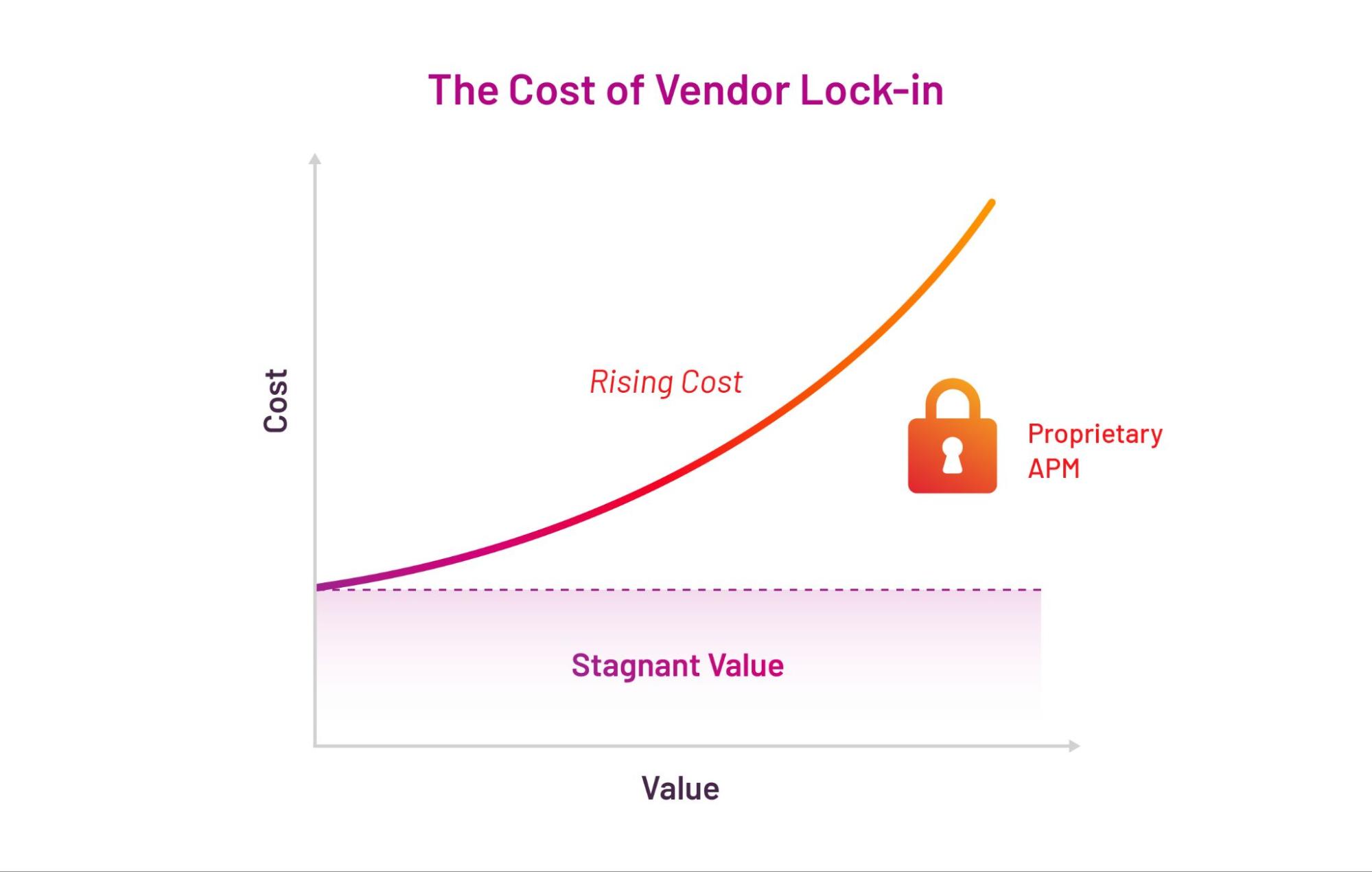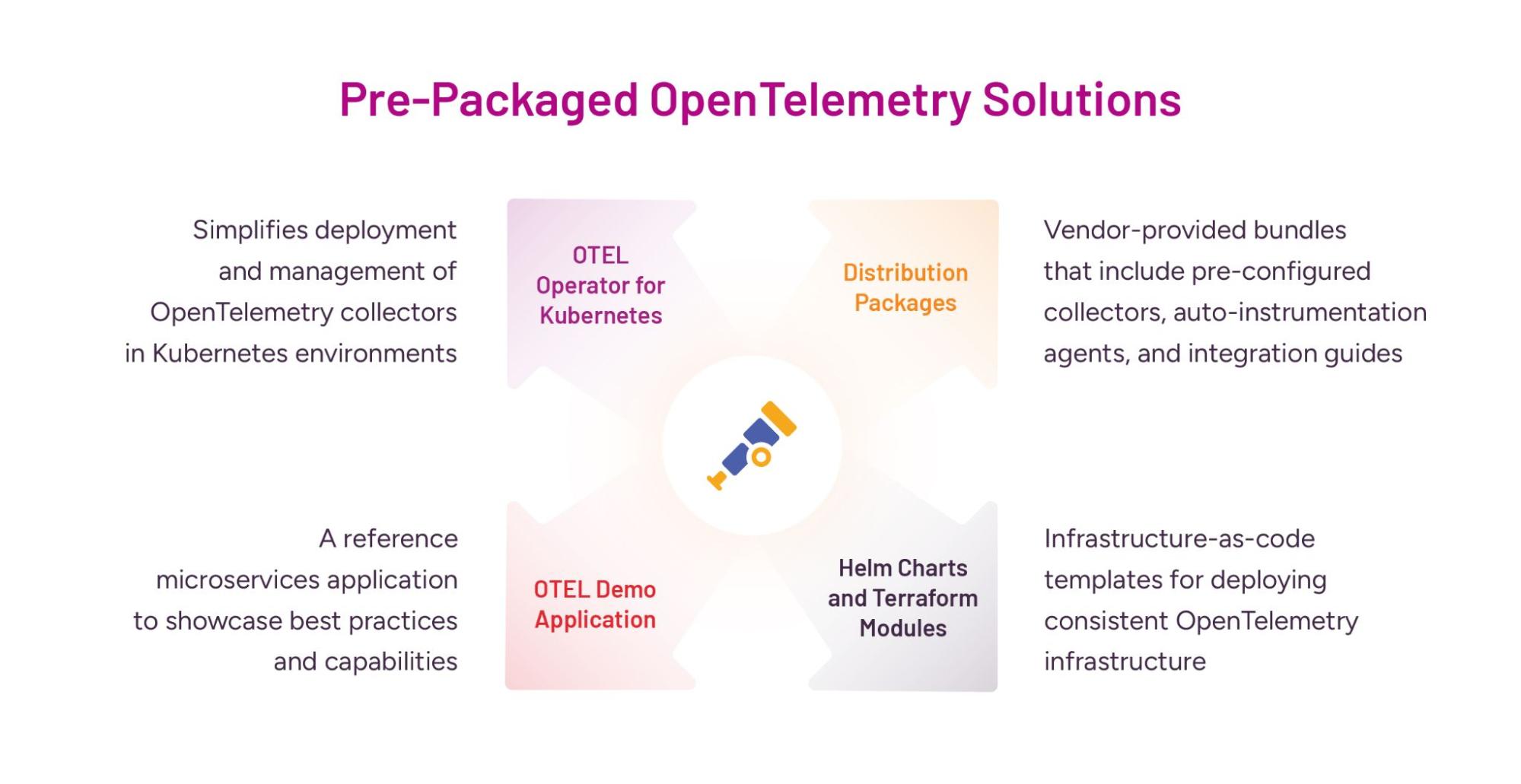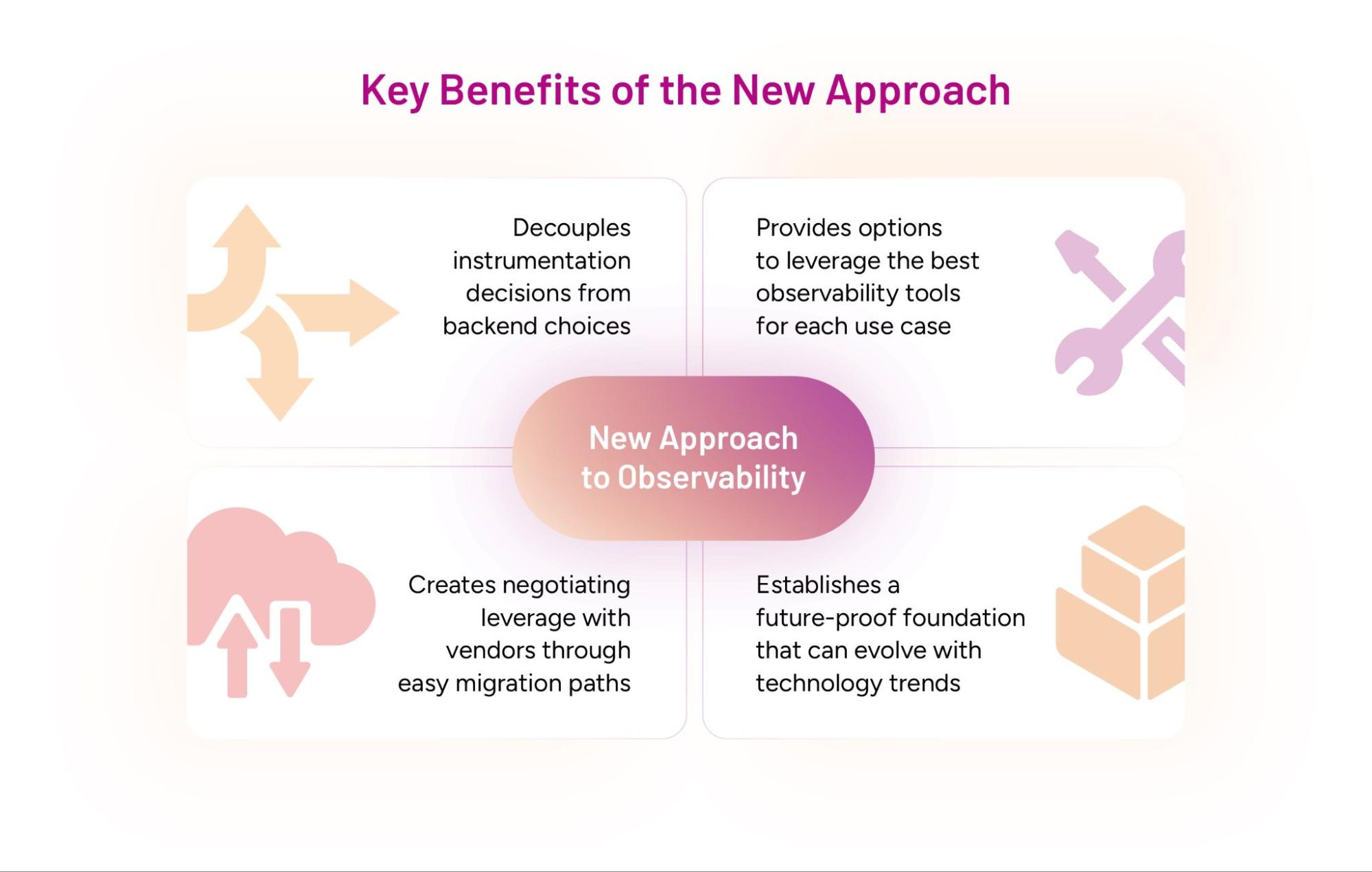Escaping the Observability Lock-In: Why OpenTelemetry Is the Future
- Jul 14, 2025
- Blogs
- 7 min read
Have your observability costs gone up, but your insights stayed the same?
If that sounds familiar, you’re not alone. Many enterprises are stuck with expensive Application Performance Monitoring (APM) tools that don’t scale or adapt to modern systems.
Modern distributed systems produce overwhelming amounts of telemetry—metrics, logs, and traces. But most organizations still struggle to collect, correlate, and use this data effectively because:
- Data formats are inconsistent between tools
- Vendors enforce lock-in through proprietary agents
- Observability silos block end-to-end insights
- Custom use cases are not well supported
- Scaling for data growth comes with exponential costs
- Migration means painful re-instrumentation


Fig 1: Costs of APM Tool Lock-in
The result is a fragmented observability landscape where critical insights remain buried in incompatible data formats, escalating costs, and reduced operational agility.
Enter OpenTelemetry (OTEL)—the rising industry standard that’s reshaping how enterprises approach observability. Let’s explore why this open-source framework is quickly becoming the foundation of modern observability strategies and how it enables organizations to escape the proprietary APM trap.
OpenTelemetry: The Foundation of Modern Observability
OpenTelemetry (OTEL) is the open-source solution the industry has been waiting for. It is transforming how organizations collect, process, and utilize telemetry data. Backed by the Cloud Native Computing Foundation (CNCF), it’s becoming the new standard for observability because it delivers:
- Unified instrumentation across programming languages and frameworks
- Vendor-agnostic data collection, free from proprietary agent lock-in
- Consistent semantic conventions that standardize how telemetry data is structured
- Extensible pipelines for data processing, transformation, and routing
- Backward compatibility with existing observability tools and platforms
It’s flexible, future-ready, and puts control back in your hands.
Technical Architecture of OpenTelemetry
OpenTelemetry’s architecture consists of several key components:
1. Language-Specific SDKs: SDKs for numerous programming languages (Java, Python, Go, .NET, JavaScript, and more), enabling developers to instrument their code using standardized APIs.
2. Instrumentation Libraries: Auto-instrumentation libraries for popular frameworks and technologies without changing your code.
3. OpenTelemetry Collector: A versatile component that can receive, process, and export telemetry data. The collector supports:
- Multiple receiving formats (OTLP, Jaeger, Prometheus, Zipkin, etc.)
- Data processing pipelines with filtering, batching, and transformation
- Export data to various backends via a plugin architecture
- Load balancing and high-availability configurations
4. OpenTelemetry Protocol (OTLP): A standardized protocol for consistent transmission of all types of observability signals.
5. Semantic Conventions: Standardized attribute names and values that ensure telemetry data is consistent and meaningful across different systems and services.
Pre-packaged Solutions for OpenTelemetry
The OpenTelemetry ecosystem has developed several pre-packaged solutions to simplify adoption and help teams onboard faster with minimal friction.


Fig 2: Pre-Packaged OpenTelemetry Solutions
Why Leading Enterprises Are Embracing OpenTelemetry
Organizations across sectors—especially financial services—are re-evaluating their APM investments in light of escalating telemetry data volumes and tighter budgets. The primary reasons driving this change are the hidden costs, lock-ins, and inflexibility of black-box APM solutions.
1. Exponential Data Egress Fees
As your applications generate more telemetry data, proprietary APM costs can quickly spiral out of control. Many vendors price by data volume, forcing teams to limit observability coverage, precisely when you need it most.
2. Limited Control and Customization
Black-box APM tools often restrict how telemetry is captured, transformed, and routed, impeding integration and adapting to changing business needs.
3. Lack of Extensibility
Proprietary black-box tools rarely support unique business contexts or domain-specific metrics, forcing organizations to run overlapping solutions.
4. Future Migration Challenges
While switching APM providers, organizations often face the daunting prospect of re-instrumenting their entire application portfolio—a costly and time-consuming process.
New Approach to Observability: “Start Vendor-Agnostic, Stay Portable”
Forward-thinking organizations are adopting a new philosophy for observability: start with vendor-agnostic instrumentation and maintain flexibility throughout your observability journey. This shift is particularly evident in banking, securities, and other regulated sectors where cost control and data sovereignty are non-negotiable.


Fig 3: Key benefits of the New Approach
How VuNet Powers Business-Centric OpenTelemetry
At VuNet, we’ve recognized OpenTelemetry’s strategic importance since its inception. Rather than treating it as just another data source, we’ve built our platform with OpenTelemetry at its core. Our platform offers several distinct advantages for organizations adopting OpenTelemetry:
1. Native OTLP Ingestion: VuNet directly ingests data via the OpenTelemetry Protocol (OTLP) without requiring transformation or intermediary collectors, preserving data fidelity and reducing infrastructure complexity.
2. Intelligent Sampling and Retention: Our platform applies adaptive sampling to maintain observability coverage while controlling data volume and storage costs. VuNet does tail sampling for better capture of failure rates and high-latency transactions – improving application performance.
3. Cross-Signal Correlation Engine: VuNet uniquely correlates metrics, logs, and traces with its proprietary vu3T correlation engine to generate business context from IT data and generate comprehensive unified visibility.
4. Unified Transaction Mapping: Automatically generate maps stitching all OpenTelemetry trace data, helping in visualising and troubleshooting complex distributed systems.
5. Seamless Hybrid Deployment Support: VuNet’s architecture supports consistent telemetry collection across all deployment models – on-premise, cloud or hybrid environments.
6. OpenTelemetry Collector Management: Centrally configure, deploy, and monitor your OpenTelemetry collectors from the VuNet platform, ensuring consistent data collection across your infrastructure.
7. Pre-built Integration Packages: VuNet provides ready-to-use configurations for common technologies:
- Kubernetes monitoring with auto-discovery
- Cloud service provider integrations (AWS, Azure, GCP)
- Application server telemetry (JVM, .NET, Node.js)
- Database performance monitoring
- Network telemetry collection
These capabilities of VuNet’s platform ensure that organizations can leverage their OpenTelemetry investments while gaining the advanced analytics and business context that they require.
Delivering Business Context Beyond Basic Telemetry: VuNet’s Differentiation
While OpenTelemetry provides excellent technical observability, true business value comes from connecting this telemetry to business outcomes. We’ve built deep, native integrations to help enterprises turn technical telemetry into business insights. VuNet delivers this capability by:
1. Contextualizing technical signals with business metadata and KPIs.
2. Correlating across domains and systems to create a unified view of business journeys and transactions.
3. Assigning AI/ML models to abnormal patterns of system performance to detect anomalies and alert on business impact.
4. Enabling sophisticated Root Cause Analysis (RCA) powered by AI, enabling drill-down from business impact to system-level issues for accelerating resolution.
5. Providing business-oriented dashboards and reports that translate technical metrics into business impact.
6. Correlate backend telemetry with real user monitoring and synthetic transactions to understand how technical performance affects user experience.
Taking the First Step Toward OpenTelemetry Adoption
Transitioning to an OpenTelemetry-based observability strategy doesn’t require a disruptive “rip and replace” approach. Organizations can implement a phased adoption strategy:



Fig 4: Approach to OpenTelemetry Adoption
Conclusion: Observability Freedom Starts with OpenTelemetry
As distributed systems continue to grow in complexity, proprietary APM solutions are no longer sustainable. OpenTelemetry represents not just a technical standard but a strategic shift toward observability.
By embracing OpenTelemetry and partnering with platforms like VuNet that amplify its potential to deliver business context, organizations can finally align technical observability with business outcomes while controlling costs and breaking free from vendor lock-in.
The question isn’t whether to adopt OpenTelemetry, but how quickly you can leverage it to future-proof your foundation of observability.
Ready to explore how VuNet can help you implement an OpenTelemetry-based observability strategy while enriching your telemetry with business context and advanced analytics?
Contact our team of experts today to start your journey toward observability freedom.
Table of Contents
- OpenTelemetry The Foundation of Modern Observability
- Technical Architecture of OpenTelemetry
- Pre-packaged Solutions for OpenTelemetry
- Why Leading Enterprises Are Embracing OpenTelemetry
- New Approach to Observability "Start Vendor-Agnostic, Stay Portable"
- How VuNet Powers Business-Centric OpenTelemetry
- Delivering Business Context Beyond Basic Telemetry VuNet’s Differentiation
- Taking the First Step Toward OpenTelemetry Adoption
- Conclusion Observability Freedom Starts with OpenTelemetry










